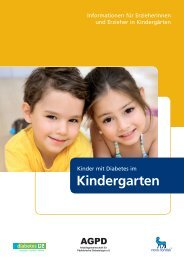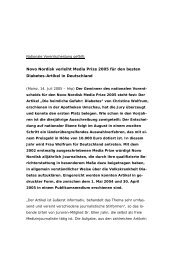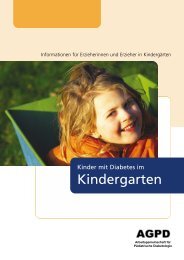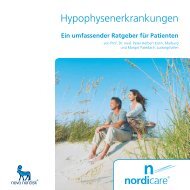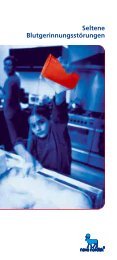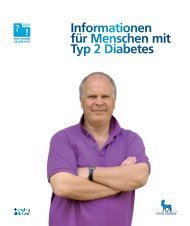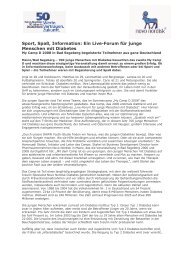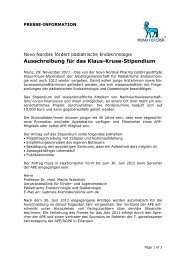Stellungnahme der Firma Novo Nordisk Pharma GmbH zu ... - Aktuell
Stellungnahme der Firma Novo Nordisk Pharma GmbH zu ... - Aktuell
Stellungnahme der Firma Novo Nordisk Pharma GmbH zu ... - Aktuell
Erfolgreiche ePaper selbst erstellen
Machen Sie aus Ihren PDF Publikationen ein blätterbares Flipbook mit unserer einzigartigen Google optimierten e-Paper Software.
• The administration of rapid-acting analogues immediately before meals has been<br />
consi<strong>der</strong>ed to be preferable to patients and families and data suggest reductions in<br />
postprandial glucose rise. Insulin regimens using rapid-acting insulin analogues have<br />
been shown to be associated with improved metabolic control compared to those<br />
using regular insulin, however limited data in children has not confirmed this<br />
advantage. Patients using rapid-acting analogues in physiological regimens overall<br />
have fewer hypoglycaemic episodes than those using traditional insulins, … In<br />
consi<strong>der</strong>ing the timing of insulin injections, data are inconsistent on the optimal<br />
timing of short-acting insulin in relation to meals, however pharmacokinetic data<br />
suggest that short-acting insulin should be given before meals and preferably up to<br />
30 minutes prior. It is recommended that rapid-acting insulins be given immediately<br />
prior to meals (within 15 minutes) to avoid hypoglycaemia. Giving rapid-acting insulin<br />
after meals has been shown to be a useful option, particularly in infants and young<br />
children with unpredictable eating patterns, allowing the dose to be judged after the<br />
amount of food ingested has been observed. 13<br />
Canada:<br />
• In type 1 DM patients, treatment with Ilis or Iasp significantly reduced HbA1c levels,<br />
compared to HI. The occurrence of overall and severe hypoglycaemia was similar with<br />
the two treatments, but nocturnal hypoglycaemia was less frequent with Ilis<br />
compared with HI. 14<br />
• When all eight RCTs— with a total of 2,948 patients and comparing IAsp with HI —<br />
were pooled, the HbA1c level was found to be lower with IAsp compared with HI<br />
(Figure 4). This difference was small but statistically significant [WMD (95% CI)<br />
=−0.14 (−0.22, −0.07)].When the RCTs were grouped according to drug<br />
administration (MDI or CSII), the differences were significant [WMD (95% CI)=−0.12<br />
(−0.20, −0.04) and −0.31 (−0.54, −0.08) for MDI and CSII respectively). There was<br />
no heterogeneity across trials (I2=0%). … In summary, type 1 patients treated with<br />
ILis or IAsp had lower HbA1c levels than those treated with HI. This difference was<br />
small (between −0.09 to −0.14) but significant. The difference was more pronounced<br />
(between −0.28 to −0.31) in patients using CSII. 15<br />
• For nocturnal hypoglycemia, two of three trials, with a total population of 273<br />
patients, showed a significant reduction in incidence with IAsp therapy, 0.5±0.83<br />
versus 0.9±0.97 (p=0.004 ) episodes per patient per 30 days and 0.80 versus 2.70<br />
(p=0.001) episodes per patient per year respectively. 16<br />
• Ten trials compared the effect of IAsp and HI on the eight-point blood glucose profiles<br />
in patients with type 1 diabetes Treatment with IAsp significantly lowered blood<br />
glucose concentrations post-breakfast, post-lunch, and post-dinner in six, four, and<br />
eight trials respectively. … In summary, details of the blood glucose profile data<br />
30/40



